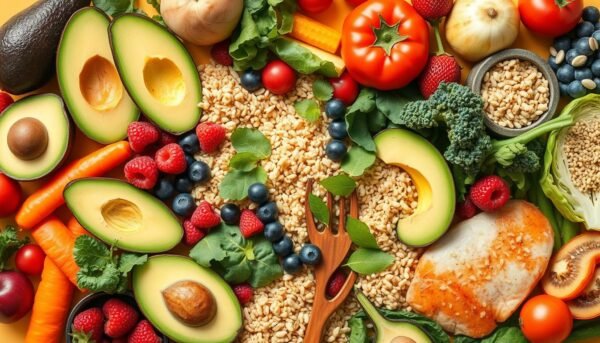Looking in the mirror, I saw the extra weight staring back at me. It was a constant reminder of my unmet goals. I decided it was time to take action, to start a journey that would change my life.
If you’re like me, trying to lose weight and stay healthy, you’re not alone. With the right mindset and plans, we can make this journey rewarding and lasting.
Successful weight loss isn’t just about the number on the scale. It’s about making lasting changes to our health. By adopting a balanced lifestyle, we can lose weight and keep it off.
In this guide, I’ll share tips, insights, and advice from experts. Together, let’s work towards a healthier, happier you.
Understanding Your Weight Loss Journey

Starting a weight loss journey is both exciting and daunting. It’s important to first check your current health. This helps set realistic goals and find what motivates you.
Assessing Your Current Health Status
Start by looking at your weight, BMI, and fitness level. Think about any health issues or medicines that might affect your weight loss. This info is key to tracking your progress and making sure your goals are safe.
Setting Realistic Weight Loss Goals
Try to lose 1-2 pounds a week, as experts suggest. Losing weight slowly is better than fast. Aiming to lose 5-10% of your weight can improve your heart health and reduce inflammation.
Identifying Personal Motivation Factors
Think about why you want to lose weight. Is it for better health, more energy, or to feel more confident? Write down your reasons and look at them often to stay motivated. Making a commitment contract can also help you stay on track.
Remember, the secret to losing weight is finding a plan that works for you. Avoid strict diets that are hard to stick to. With the right mindset and plan, you can start a journey to better health and well-being.
Creating a Sustainable Calorie Deficit Plan

For lasting weight loss, you need to eat fewer calories than you burn. This might seem easy, but it’s not. You must make sure you get enough nutrients while losing weight slowly.
For healthy weight loss, aim for a 500-calorie daily deficit. This means eating 1,200 to 1,500 calories a day for women and 1,500 to 1,800 for men. Don’t eat too little, as it’s not good for you.
There are many ways to cut calories. You can eat less, move more, or do both. For example, eating 500 fewer calories or burning 500 more calories through exercise both work. Choose what fits your life best.
| Weight Loss Approach | Calorie Deficit | Potential Weekly Weight Loss |
|---|---|---|
| Reducing 500 calories per day | 500 calories | 1 pound |
| Burning 500 calories through exercise | 500 calories | 1 pound |
Your calorie needs change based on age, sex, height, weight, and more. A big calorie deficit can harm you. Always talk to a doctor to find the right plan.
Healthy ways to cut calories include eating smaller portions and choosing whole foods. High-fiber and high-protein breakfasts help you stay full and snack less.
Combining diet changes with exercise is key for lasting weight loss. Do strength training two times a week and regular cardio. With the right plan and effort, you can reach your weight goals and stay healthy.
How to Lose 50 Pounds: A Comprehensive Strategy

Losing 50 pounds might seem hard, but it’s doable with the right plan. You need a good exercise routine, a healthy diet, and to track your progress. This helps you make changes as you go.
Developing a Progressive Exercise Routine
To lose 50 pounds, aim for 150 minutes of moderate exercise weekly. This can be brisk walking, cycling, or swimming. Also, do strength training twice a week to build muscle and speed up your metabolism.
Begin with light weights and slowly increase the weight and workout time. This will help you get better and avoid injury.
Adjusting Your Diet for Maximum Results
Creating a calorie deficit is key for losing weight. Eat whole, nutrient-rich foods like lean proteins, complex carbs, and fiber-rich fruits and veggies. Cut down on added sugars, refined carbs, and unhealthy fats.
Try intermittent fasting or eating more protein to see better results. These changes can help you lose weight faster.
Tracking Progress and Making Adjustments
Tracking your progress is vital to stay motivated and adjust your plan as needed. Use a food journal, app, or website to keep an eye on calories, macronutrients, and weight changes. Check your goals and strategies often and change them if needed.
Being consistent and flexible is crucial for losing 50 pounds. Remember, losing weight is a journey. With a good workout routine and fat loss supplements plan, you can reach your goal. Stay committed, celebrate your wins, and be patient. Your health is worth it.
Building Healthy Eating Habits for Long-term Success

Long-term weight loss isn’t just about dieting. It’s about making healthy eating habits that last. Eat a variety of foods like fruits, veggies, whole grains, and lean proteins. These foods are full of nutrients and help you lose weight and feel better.
Mindful eating is key. Listen to your body’s hunger and fullness signals. Avoid eating out of boredom or emotions. Plan meals and keep healthy foods handy. Stay away from processed foods, added sugars, and unhealthy fats.
Drinking water is also important. Drink lots of water and cut down on sugary drinks. These small changes can help you lose weight and get healthier.
Incorporating Fiber and Complex Carbohydrates
Fiber and complex carbs are vital for a healthy lifestyle and weight loss. Aim for 25 to 30 grams of fiber daily from whole grains, fruits, veggies, and legumes. These foods make you feel full and support digestion and blood sugar.
Complex carbs, like those in whole grains, are also key. They give you energy, help control blood sugar, and support a healthy gut. Eating more fiber and complex carbs helps you build a healthy lifestyle.
Embracing Healthy Fats
Not all fats are bad. Healthy fats in avocados, nuts, seeds, and olive oil can help you lose weight. They make you feel full and boost your metabolism.
But, limit bad fats like saturated and trans fats. They can harm your health and slow down weight loss. Choosing the right fats fuels your body and supports your health.
| Nutrient | Recommended Daily Intake |
|---|---|
| Fiber | 25-30 grams |
| Protein | 10-35% of daily calories |
| Sleep | 7-9 hours per night |
Focus on a healthy lifestyle with a balanced diet, exercise, and enough sleep. Sustainable weight loss is a journey. By making small, lasting changes, you can reach your goals and stay healthy for years.
Essential Nutrients for Weight Loss and Fat Burning

For lasting weight loss and fat burning, it’s not just about eating less. You need the right nutrients to boost your metabolism, stay full, and stay healthy. Let’s explore the key nutrients that can help you lose weight.
Protein Requirements for Fat Loss
Enough protein is key to keep your muscles when you lose weight. Research shows a high-protein diet helps with weight loss and fights obesity-related diseases. Protein burns more calories when you digest it than carbs and fats do. Eat lean proteins like eggs, cottage cheese, Greek yogurt, and lean meats to help burn fat.
Importance of Fiber and Complex Carbohydrates
Fiber and complex carbs are vital for weight loss. Fiber makes you feel full and controls blood sugar, stopping energy crashes that lead to eating too much. Good sources include oats, quinoa, brown rice, and beans. They give you lasting energy and keep your digestive system healthy.
Healthy Fats and Their Role in Weight Loss
Healthy fats can actually help you lose weight. Fats from avocados, nuts, olive oil, and fatty fish make you feel full, improve nutrient absorption, and boost metabolism. But, eat them in moderation because they have a lot of calories. Adding healthy fats to your diet can help you lose weight in a healthy way.
| Nutrient | Benefits for Weight Loss and Fat Burning |
|---|---|
| Protein | Supports muscle maintenance, increases feelings of fullness, and has a higher thermic effect. |
| Fiber | Promotes feelings of fullness, regulates blood sugar levels, and supports a healthy digestive system. |
| Healthy Fats | Contributes to feelings of satiety, improves nutrient absorption, and supports metabolic function. |
Focus on these essential nutrients for a fat burning diet that helps you lose weight and stay healthy. A balanced diet with many nutrient-rich foods is the best way to boost your metabolism and achieve lasting success.
Smart Exercise Strategies for Weight Management

For lasting weight loss, mix cardio and strength training. As a weight loss coach, I’ve seen how enjoying your workouts boosts your commitment. This helps you reach your weight management goals.
Cardio like walking, jogging, or cycling burns calories and boosts fitness. Aim for 150 minutes of moderate cardio weekly, or 75 minutes of vigorous.
Strength training is key for weight loss. It builds muscle and boosts your metabolism. Do two to three strength training sessions weekly, focusing on exercises that work many muscles.
Joining a fitness class or working out with friends can keep you motivated. The social aspect and shared goals are powerful for weight loss motivation. Plus, a fun playlist can make your workout routine more enjoyable.
Start with easy exercises and slowly increase the challenge. Consistency is crucial. Find activities you love and make them a regular part of your life.
| Exercise Type | Recommended Frequency | Benefits |
|---|---|---|
| Strength Training | 2-3 sessions per week | Builds and maintains muscle mass, increases metabolism |
| Swimming | 2-3 sessions per week | Low-impact, suitable for individuals with joint pain or arthritis |
| Interval Training | 2-3 sessions per week | Targets fat loss, particularly in the belly region |
| Cycling | 3-4 sessions per week | Moderate-intensity exercise that burns calories |
Mindful Eating and Portion Control Techniques

Starting a healthy lifestyle means knowing about portion control. We know about serving sizes, but using them in our daily eating is hard. But, mastering portion control can really help with weight loss and health.
Understanding Serving Sizes
The Nutrition Facts label on food packages tells us about serving sizes. But, the amount we eat might not match the serving size. This can lead to eating more calories than we want, which can stop our weight-loss plans.
To match your portions with your goals, use tools like measuring cups and digital scales. Also, learn about common serving sizes for different foods. This helps you make better choices all day.
Practicing Mindful Eating Habits
- Slow down and enjoy each bite, noticing the flavors and textures.
- Don’t eat while watching TV, using phones, or laptops. Stay focused on your food.
- Use smaller plates and bowls to control your portions and feel fuller.
- Be aware of emotional reasons for eating too much. Find other ways to cope.
- Drink lots of water to avoid mistaking thirst for hunger.
By adding these mindful eating habits to your daily life, you’ll enjoy your meals more. You’ll also manage your portions better and reach your weight-loss goals. Remember, portion control is key to a healthy lifestyle. Make it a big part of your journey to better health.
| Metric | Value |
|---|---|
| Portion Control | Crucial for weight loss |
| Serving Size | FDA-defined, label on food |
| Portion Size | Amount of food you actually eat |
| Overweight/Obese Adults in the U.S. | 73.6% |
| Obesity Rate in the U.S. | 41.9% |
| Weight Loss Recommendation | 5-10% of body weight |
| Water Intake Recommendation | 8 glasses (64 oz) per day |
| Sleep Recommendation | 7-9 hours per night |
Overcoming Weight Loss Plateaus and Challenges
Reaching your weight loss goals can feel like a roller coaster ride. Even with a healthy diet and regular exercise, the scale might stop moving. This is called a weight loss plateau, and it’s frustrating.
But, you can beat these challenges. With the right strategies, you can keep moving towards a healthier, happier you.
Weight loss plateaus are a natural part of losing weight. As you lose pounds, your metabolism slows down. This makes it harder to lose more weight.
Research shows that losing 5 to 10 percent of your body weight can slow your metabolism by 15 percent. You might need to eat fewer calories or exercise more to keep losing weight.
It’s also easy to get tempted to skip workouts or fall back into bad habits. Missing one workout can make you miss another by 61 percent. Staying consistent in the gym is key, even if it’s not always exciting.
Adding more movement to your day can also help. This keeps your metabolism up and aids in weight loss.
Keeping your muscle mass up is important too. Aim for 0.8 to 1 gram of protein per kilogram of body weight. This helps grow muscle and burn fat.
Don’t overestimate how active you are. This can lead to less activity overall. Also, eating too much after working out can slow down your weight loss.
Stress, emotional eating, and strict diets can also cause plateaus. Getting support from professionals or groups can help you stay on track.
Remember, losing weight is not always easy. Setbacks are normal. By understanding plateaus and adjusting your approach, you can reach your goals.
Creating a Supportive Environment for Success

Losing weight and staying healthy is a long journey. Having the right support can make a big difference. Surround yourself with people who encourage and motivate you. This will help you stay committed to your weight loss goals.
Building a Support Network
Talk to your family and friends about your weight loss journey. Ask for their help in keeping you motivated. Join a local or online weight loss group to meet others with similar goals.
Sharing your progress and challenges with a supportive network can boost your motivation. It helps you stay on track.
Organizing Your Kitchen for Healthy Eating
Your home environment is key to weight loss motivation and a healthy lifestyle. Organize your kitchen to support healthy eating. Keep healthy foods like fruits, veggies, lean proteins, and whole grains in sight.
Get rid of high-calorie snacks and sugary drinks. Make healthy choices easy to make. This way, you’ll be more likely to follow your nutrition plan.
| Healthy Kitchen Essentials | Items to Limit or Remove |
|---|---|
|
|
By creating a supportive environment and making healthy choices easy, you’ll reach your weight loss and healthy lifestyle goals.
Maintaining Weight Loss: Long-term Strategies
Reaching your weight loss goals is just the start. The real battle is keeping that progress going. By making lasting lifestyle changes, you can achieve lasting success and a healthier life.
To keep the weight off, focus on your health every day. Watch your food and weight closely. Change your workouts to avoid boredom and keep your body strong. Celebrate small wins like more energy and better sleep to stay motivated.
Weight loss isn’t always easy. You might face setbacks, but having plans to bounce back is key. Think of progress, not perfection. Small, steady steps can lead to big results. By choosing a healthy lifestyle, you can keep your weight loss and enjoy a fitter, more vibrant life.
This post may contain affiliate links which means I may receive a commission for purchases made through links. I will only recommend products that I have personally used! Learn more on my Private Policy page.